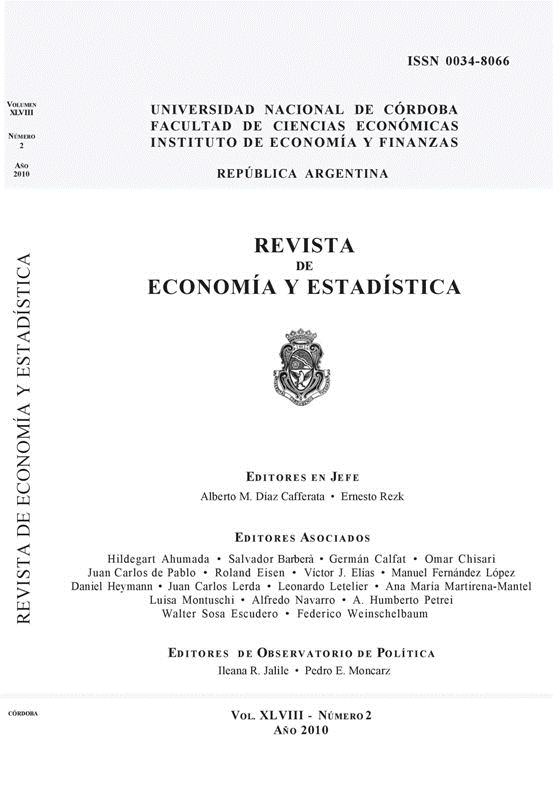The Impact of the International Financial Crises Upon Emerging Economies and the Performance of Discretionary Fiscal Policies: The Case of Argentina
DOI:
https://doi.org/10.55444/2451.7321.2010.v48.n2.4106Keywords:
international financial crises, discretionary fiscal policies, ArgentinaAbstract
Although international crises partially accounted for the recent weakArgentine economic performance, main causes have to be sought in domesticeconomic policies adding uncertainty to the decision process of economicsectors and amplifying crises’ effects. Government revenues exhibiteda positive, though decreasing, evolution explained by a contraction oftax revenues despite transfers from the eliminated Private Pension Systemand IMF`s special draw rights. However, public spending was in the rootof the government’s fi scal strain as their growth rate outweighed that ofrevenues and caused an erosion of the primary surplus, whose present levelartifi cially stemmed from exceptional revenue fl ows and the discretionaryseizing of pension funds. Finally, although the overall cyclical sensitivity of tax revenues increased, budget balance’s response to GDP did not suffi ce tocheck cycles and active fi scal policies had to strengthen stabilizing actions.
Downloads
References
Auerbach, A. A. (2002), “Is there a role for discretionary fiscal policy?, Working Paper 9306, NBER, Cambridge, MA.
Auerbach, A. A. (2009), “Implementing the New Fiscal Policy Activism”, American Economic Review: Papers and Proceedings, 99:2.
Blanchard, O. and R. Perotti (1999), “An empirical characterization of the dynamic effects of changes in government spending and taxes on output”, NBER, Working Paper Number 7269.
Cohen, D. and G. Follete (2000), “The Automatic Fiscal Stabilizers: Quietly Doing their Thing”, Frbny Economic Policy Review, (April).
Friedman, M. (1948), “A Monetary and Fiscal Framework for Economic Stability”, The American Economic Review, Vol. 38, Nº 3 (June).
Uxo Gonzalez, J., Gutierrez, J. P. and J. Salinas (2009), “El Programa Español de Estímulo Fiscal frente a la Crisis: Justificación, Características y Comparación Internacional”, 42 Jornadas Internacionales de Finanzas Públicas, Córdoba, Argentina.
Germany, Federal Republic of, Sachverstandigenrat zur Begutachtung der Sesamtwirtschaftlichin Entwicklung (Bonn: November 24, 1983), pp. 267-68.
Girouard, N and André, C (2005), “Measuring cyclically-adjusted budget balances for OECD countries”, OECD Economics Department Working Papers, No. 434.
Hagemann, R (1999), “The structural budget balance. The IMF’s methodology”, International Monetary Fund, Office in Europe.
Heller P., Haas R. and Mansur A. (1986), “A review of the fiscal impulse measure”, International Monetary Fund Washington D.C.
International Monetary Fund (2009), “The State of Public Finances: Outlook and medium-term policies after the 2008 crisis”, (approved by Carlo Cotarelli) Washington.
Johansen, L. (1971), “Public Economics”, North-Holland, The Netherlands.
Lucas, R. E. (1976), “Econometric Policy Evaluation: A Critique”. In The Phillips Curve and Labor Markets, Karl Brunner and Allan Meltzer Eds., North-Holland, Amsterdam.
Muller, P. and Price, R. W. (1984), “Structural Budget Deficits and Fiscal Stance”, OECD Economics Department Working Papers, No. 15, OECD Publishing.
Musgrave, R. A. and M. H. Miller (1948), “Built-in Flexibility”, The American Economic Review, Vol. 38, Nº 1 (March).
Rial Perez, I. (1995), “La Política Fiscal en el Uruguay: indicadores de orientación discrecional, 1983-1993”, Revista de Economía, Vol. 2. May, Uruguay.
Rezk, E. (1982), “Flexibilidad Automática en Argentina: Un ejercicio macroestático”, Anales de las 15º Jornadas de Finanzas Públicas, Córdoba, Argentina.
Romer, C. (1999), “Changes in Business Cycles: Evidence and Explanations”, Journal of Economic Perspectives, Spring.
Spilimbergo, A, Symansky, S., Blanchard, O. and C. Cotarelli (2008), “Fiscal Policy for the Crisis”, SPN/08/01, International Monetary Fund, Washington.
Taylor, J. B. (2008), “The lack of an empirical rationale for a revival of discretionary fiscal policy”, Stanford University.
Taylor, J.B. (2000), “Reassessing Discretionary Fiscal Policy”, Journal of Economic Perspectives, Vol. 14, Number 3 (Summer).
Van der Noord, P. (2000), “The size and role of automatic fiscal stabilizers in the 1990s and beyond”, OECD Economic Department Working Papers, No. 230, OECD Publishing.
Downloads
Published
How to Cite
Issue
Section
License
Copyright (c) 2010 Ernesto Rezk, Ginette Lafit, Vanina Ricca

This work is licensed under a Creative Commons Attribution-NonCommercial-NoDerivatives 4.0 International License.
Authors who have publications with this journal agree to the following terms:
Authors retain their copyright and grant the journal the right of first publication of their work, which is simultaneously subject to the Creative Commons Attribution-NonCommercial-NoDerivatives 4.0 International License that allows third parties to share the work provided that its author and first publication in this journal are indicated.
Authors may adopt other non-exclusive licensing arrangements for distribution of the published version of the work (e.g. depositing it in an institutional telematic archive or publishing it in a monographic volume) as long as the initial publication in this journal is indicated.
Authors are allowed and encouraged to disseminate their work via the Internet (e.g. in institutional telematic archives or on their website) before and during the submission process, which can lead to interesting exchanges and increase citations of the published work. (See The Open Access Effect)









